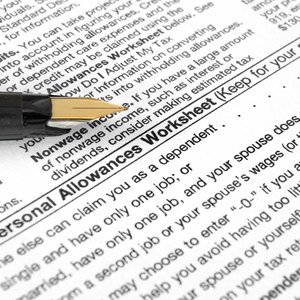
As a taxpayer, you are able to take the maximum allowances on your W-4 that you’re eligible to claim. However, don’t try to get away with claiming more than you’re entitled to. In case of tax withholding non-compliance, the IRS will issue your employer a lock-in letter. This letter notifies him as to the maximum amount of withholdings you’re allowed to claim. As an employee, the IRS gives you a chance to prove that your withholdings are valid. If you cannot prove the number of withholdings you were attempting to claim, then the maximum number of withholdings set forth by the IRS in the lock-in letter are upheld. In order to avoid this, it’s best to use the interactive tax assistant tools on the IRS’ website, or consult with your tax preparer to ensure you aren’t claiming too many allowances.
Tips
The IRS does not have a standard maximum number of allowances taxpayers are allowed to claim. When completing your W-4, you are legally entitled to claim as many allowances as you qualify for. It is important to note, however, that you will have to pay the tax you owe on your income at some point, be it through your regular paycheck or following the filing of your tax return.
Exemptions, Allowances and Misconceptions
Taxpayers often use the terms allowances and exemptions interchangeably. The reality is, they’re quite different. You can claim one exemption for yourself, your spouse and all qualifying dependents, and these exemptions are claimed on your IRS Form 1040, not your W-4. There are no maximum dependents you can claim, as long as you are eligible to claim them. Exemptions on your Form 1040 decrease the amount of income you’re able to be taxed on – which lowers your tax obligation. These exemptions may equal the number of allowances you decide to claim on your W-4, but they also may not. However because of recent tax reforms, for tax years 2018 through 2025, you are no longer able to claim personal exemptions when you file taxes, but you can still claim allowances on your W-4.
Allowances, on the other hand, are claimed on the W-4 your employer has you fill out when you begin employment. This form is what determines how much in taxes you can expect to have withheld from every paycheck. The number of allowances you may claim can coincide with the number of exemptions you end up claiming on your Form 1040, although for your personal tax situation, this may not be the case. Exemptions reduce your tax obligation, while the number of allowances you claim on your W-4 determines how large or small of a paycheck you’ll take home.
You can change your W-4 to adjust your withholdings or allowances at any time to reflect life changes that affect your filing status, such as getting married, or having a child – unless you’ve received a lock-in letter notification from the IRS for not having enough taxes withheld. In this case, to adjust your allowances, you will have to contact the IRS to let them know your situation has changed. The IRS will in turn notify your employer of the appropriate number of tax to withhold, or to keep the mandated maximum numbers of allowances of the lock-in letter in place.
Should I Claim More or Less Allowances?
How many allowances you claim on your W-4 largely depends upon whether you’d like to increase your odds of a refund, or if you’d like to take home a larger paycheck every pay period. Claiming more allowances means that your employer will withhold less taxes from every paycheck. Some workers prefer this tax situation because they can decide to invest the extra money per paycheck as they see fit. However, taxpayers who opt for this method of tax withholding may face hefty tax obligations when it comes time to file their returns.
When you claim less allowances, you will take home less wages per period, but you greatly increase your odds of overpaying the IRS for your taxes. This is one surefire way to receive a refund, barring any delinquent obligations such as back taxes or outstanding child support payments. But, some filers view claiming less allowances as giving the IRS interest-free use of their money until they receive it back in the form of a refund. You may want to choose this option if you don't mind having a smaller paycheck, and would rather have a larger refund at tax time to pay down debt, or to use as you please.
References
Writer Bio
Tara Thomas is a Los Angeles-based writer and avid world traveler. Her articles appear in various online publications, including Sapling, PocketSense, Zacks, Livestrong, Modern Mom and SF Gate. Thomas has a Bachelor of Science in marine biology from California State University, Long Beach and spent 10 years as a mortgage consultant.
